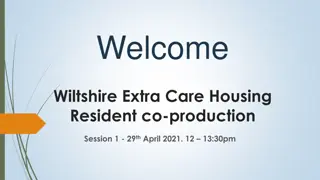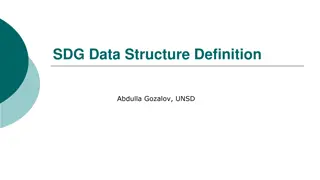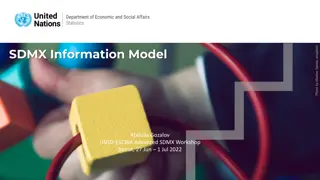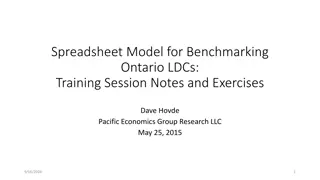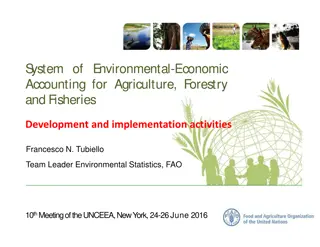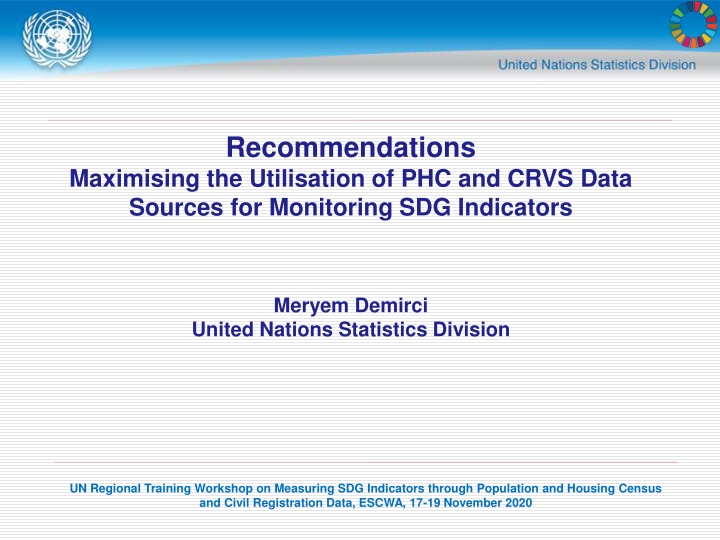
Maximising Utilisation of PHC and CRVS Data for Monitoring SDG Indicators
Explore recommendations for leveraging primary healthcare and civil registration data sources to monitor SDG indicators effectively. Learn about assessing data quality, aligning with SDG requirements, and addressing data issues in population and demography. Gain insights from the UN Regional Training Workshop held in November 2020.
Download Presentation

Please find below an Image/Link to download the presentation.
The content on the website is provided AS IS for your information and personal use only. It may not be sold, licensed, or shared on other websites without obtaining consent from the author. If you encounter any issues during the download, it is possible that the publisher has removed the file from their server.
You are allowed to download the files provided on this website for personal or commercial use, subject to the condition that they are used lawfully. All files are the property of their respective owners.
The content on the website is provided AS IS for your information and personal use only. It may not be sold, licensed, or shared on other websites without obtaining consent from the author.
E N D
Presentation Transcript
Recommendations Maximising the Utilisation of PHC and CRVS Data Sources for Monitoring SDG Indicators Meryem Demirci United Nations Statistics Division UN Regional Training Workshop on Measuring SDG Indicators through Population and Housing Census and Civil Registration Data, ESCWA, 17-19 November 2020
Content National assessment for availability of data in PHC and CRVS for computation of SDG indicators Evaluation of the quality of data Recommendations for the census questionnaire to capture information relevant to the monitoring of as many SDG indicators as possible UN Regional Training Workshop on Measuring SDG Indicators through Population and Housing Census and Civil Registration Data, ESCWA, 17-19 November 2020
Assessment of availability of data from PHC and CRVS Having good understanding of definitions of SDG indicators related to population and demography Matching PHC/CRVS data with the data requirements for SDG indicators Evaluating the quality of data to ensure that the data is reasonably in good quality to compute SDG indicators at sub- national level Making a decision on whether PHC or CRVS provides complete or partly information Reference document- UN Technical Report on Measuring SDG Indicators Through PHC and CRVS Data UN Regional Training Workshop on Measuring SDG Indicators through Population and Housing Census and Civil Registration Data, ESCWA, 17-19 November 2020
Data quality issues in the PHC and CRVS Under/over-coverage of population will have impact on the reliability of SDG indicators computed from census data as a denominator of about 90 indicators and for measuring 40 indicators Census under/over-count is significant problem if it occurs selectively in the population sub-groups relevant to the construction of the indicator In the case of CRVS data, even if its coverage is good enough such as at least 90 percent: Under-coverage rate might be higher for specific cases- such as neonatal/infant deaths and early child marriage UN Regional Training Workshop on Measuring SDG Indicators through Population and Housing Census and Civil Registration Data, ESCWA, 17-19 November 2020
Evaluation of data quality for PHC and CRVS CRVS Coverage error of vital events and the level of late registration of births and deaths - by sex, age and geographic areas PHC Coverage error of enumerated/registered population Content errors What methods can be used Post enumeration Survey (dual system estimation) Demographic methods Comparison with other data sources https://unstats.un.org/unsd/demographic-social/census/#methods UN Regional Training Workshop on Measuring SDG Indicators through Population and Housing Census and Civil Registration Data, ESCWA, 17-19 November 2020
Recommendations for census topics (1) Early child marriage In countries with a high incidence of child marriage: the question on age at (or date of) first marriage or age at (or date of) first consensual union should be included and asked to all people aged 12 (or 10) and over Birth registration In countries with significant under-registration of births and no centralised registration system, the question on whether children under age 5 have been registered 16 countries asked this question in 2010 round UN Regional Training Workshop on Measuring SDG Indicators through Population and Housing Census and Civil Registration Data, ESCWA, 17-19 November 2020
Recommendations for census topics (2) Mortality In countries which do not have reliable death registers in CRVS, the questions on: (i) the date of birth of the last live-born child (ii) the survival status of this child and (iii) the date of death of this child (iv) Household deaths can provide information relevant to the indicators of infant, child and neonatal mortality Additional questions to household deaths to estimate maternal mortality Whether the death occurred during pregnancy, childbirth, or 42 days after childbirth for females in 15-49 UN Regional Training Workshop on Measuring SDG Indicators through Population and Housing Census and Civil Registration Data, ESCWA, 17-19 November 2020
Recommendations for census topics (3) Literacy Data on literacy should be extended to distinguish broad levels of literacy skills Reading and writing may be measured separately to simplify the questions, such as: reading with understanding personal letters and newspapers or magazines, writing a personal letter or message Simple questions with response categories that reflect different levels of literacy skills should be used, such as able to do so easily, with difficulty or not at all UN Regional Training Workshop on Measuring SDG Indicators through Population and Housing Census and Civil Registration Data, ESCWA, 17-19 November 2020
Recommendations for census topics (4) Child labour For countries with a high level of child labour, it is recommended that the question on economic activity be extended to children over age 7, rather than 12 or 15, so as to allow the measurement of child labour; Occupation and industry The coding of data on occupation and industry in censuses should be in line with ISCO-08 and ISIC Rev4 to allow the identification of certain occupational/industrial groups relevant from the viewpoint of the SDG indicators, such as; ISCO-08 codes 221, 222, 2261 and 2262 for identification of health worker density and distribution (3.c.1.) four-digit coding ISIC rev 4 codes 851, 8521, 8522, 853 for identification of teachers at the pre-primary and primary, secondary levels (for 4.c.1)-four-digit coding UN Regional Training Workshop on Measuring SDG Indicators through Population and Housing Census and Civil Registration Data, ESCWA, 17-19 November 2020
Recommendations for census topics (5) Disability A more uniform application of the Washington Group questions would improve the international comparability of disability data for the disaggregation of the SDG indicators A separate question for each domain (walking, seeing, hearing , cognition, self-care or communications) with four response categories: No difficulty at all Yes, some difficulty Yes, a lot of difficulty Yes, cannot do at all UN Regional Training Workshop on Measuring SDG Indicators through Population and Housing Census and Civil Registration Data, ESCWA, 17-19 November 2020
Recommendations for census topics(6) Sources of income A list of potential sources of income with a yes/no categorization could be used to assess the coverage of social security systems in different population groups and would have significant advantages over the use of administrative data, such as Salary, interest/rental income, pension, disability pension, unemployment compensation, child support, etc. 20 countries asked a question on sources of income in 2010 round UN Regional Training Workshop on Measuring SDG Indicators through Population and Housing Census and Civil Registration Data, ESCWA, 17-19 November 2020
Recommendations for census topics (7) Use of the Internet and own a mobile phone Collecting information on the use of Internet and having a mobile phone is relatively new and countries have approached the subject in different ways, usually data collected at household level. In order to guarantee better alignment with the SDG indicators, o consider the possibility of an individual level question about internet use, with an explicit time limit of three months, in addition to asking if an internet connection is available in the household o consider the possibility of asking a question to individuals if they own a mobile telephone UN Regional Training Workshop on Measuring SDG Indicators through Population and Housing Census and Civil Registration Data, ESCWA, 17-19 November 2020
Recommendations for census topics (8) Housing characteristics It would be advisable to review all the categories of questions on housing characteristics to ensure that data is collected according to international recommendations sources of drinking water, basic sanitation and the cooking and lighting fuels should be collected for all the categories relevant for the construction of the SDG indicators o this means not conflating safe with unsafe sources UN Regional Training Workshop on Measuring SDG Indicators through Population and Housing Census and Civil Registration Data, ESCWA, 17-19 November 2020
Recommendations for census topics (9) Geospatial information Integration of geospatial data with census data provides a valuable support for the computation of several SDG indicators and disaggregation and visualization of SDG indicators computed from PHC UN Regional Training Workshop on Measuring SDG Indicators through Population and Housing Census and Civil Registration Data, ESCWA, 17-19 November 2020
Conclusions Adjusting census questionnaire, with a comparatively small investment, might expand their ability to capture information relevant to the monitoring of as many SDG indicators as possible Modifying census reports and dissemination tools with a view of presenting SDG indicators disaggregated by key policy groups and small geographic areas- can improve uses of census results by national/sub-national governments, policy makers, researchers and other users UN Regional Training Workshop on Measuring SDG Indicators through Population and Housing Census and Civil Registration Data, ESCWA, 17-19 November 2020



